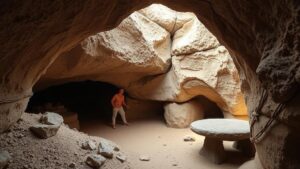Exploring the possible location of Tamuda, a Roman city lost in modern-day Morocco.
Exploring the Possible Location of Tamuda, a Roman City Lost in Modern-Day Morocco
Tamuda was an important Roman city located in what is now modern-day Morocco. This ancient settlement played a crucial role in the Roman Empires control and influence over North Africa during its height. Despite its historical significance, the exact location of Tamuda has remained elusive, sparking intrigue among historians and archaeologists alike. This article explores the potential locations of Tamuda, drawing on archaeological evidence, historical records, and modern technology.
A Brief Historical Overview
Founded during the 1st century AD, Tamuda served as a strategic military and trade hub for the Romans. Its location near the mouth of the River Martil provided natural advantages for both commerce and defense. The site is mentioned by classical authors such as Pliny the Elder, who noted its significance in trade routes connecting the hinterlands of North Africa to the Mediterranean.
By the 2nd century AD, Tamuda became an important point of Roman settlement, facilitating extensive trade networks that bolstered the economy of Roman Mauretania. city was built in a Roman grid layout, with typical structures such as temples, public baths, and villas indicative of Hellenistic influences.
The Search for Tamudas Location
The quest to identify the exact location of Tamuda has led researchers to several potential sites, each presenting compelling evidence for their claims. Among the leading candidates are:
- Ras Al Ma: This site, located near the town of Martil, has yielded scattered Roman artifacts, including pottery and coins, suggesting it may have been an important urban center during the Roman period.
- Ceuta: Geographically closer to the Strait of Gibraltar, Ceuta is thought to have been integral to maritime trade and may possess remnants of Tamuda due to its prominence in the region.
- Tamudas Ruins at Ksar el-Kebir: The presence of ancient Roman pottery and foundation remnants in this area has led researchers to speculate that this could be the actual site of Tamuda.
Archaeological Findings and Evidence
Archaeologists have utilized various technologies to unravel the mystery of where Tamuda might have been located. Ground-penetrating radar (GPR) and magnetometry are among the techniques applied to scan potential sites without extensive excavation. e non-invasive methods have revealed buried structures and extensive urban layouts that align with historical descriptions of Tamuda.
For example, excavations at Ras Al Ma have uncovered what some believe to be remnants of public baths and domestic dwellings, complete with elaborate mosaics similar to those found in other Roman cities. Also, an analysis of pottery styles suggests trade links to regions within the Roman Empire, reinforcing the sites potential as Tamuda.
The Role of Historical Texts
Ancient writings provide valuable insights into Tamudas characteristics and strategic significance. Pliny the Elder and Ptolemy described its location in relation to geographical landmarks, giving researchers a basis for identifying the site. Ptolemys references to a city near the coast and proximity to the River Martil are frequently cross-referenced with archaeological finds in the region. Understanding these historical narratives enhances our comprehension of Tamuda’s operational framework.
Modern-Day Significance and Conservation Efforts
As interest in Tamuda grows, so does the call for preservation efforts. Archaeological sites at risk of urban development require urgent attention. Moroccan government, alongside various international organizations, has initiated projects aimed at safeguarding these historical areas. Restoration efforts not only focus on physical sites but also emphasize educating local communities about their ancient heritage.
Conclusion: The Future of Tamuda Research
The location of Tamuda remains one of the enduring mysteries of Roman archeology. While several promising candidates have emerged, ongoing research is essential to validate claims through continued excavation and technological advancements. potential discovery of Tamuda would contribute significantly to our understanding of Roman influence in North Africa and its legacy that endures in modern-day Morocco.
Engagement with local historians, archaeologists, and enthusiasts will be crucial in advancing our knowledge. As the search for Tamuda continues, one can anticipate exciting discoveries that will illuminate the complexities of Roman urban life in the ancient world.
In summary, the exploration of Tamuda highlights the importance of interdisciplinary approaches in unraveling historical enigmas, combining archaeological digs with historical narratives and modern technologies for a comprehensive understanding of our past.


